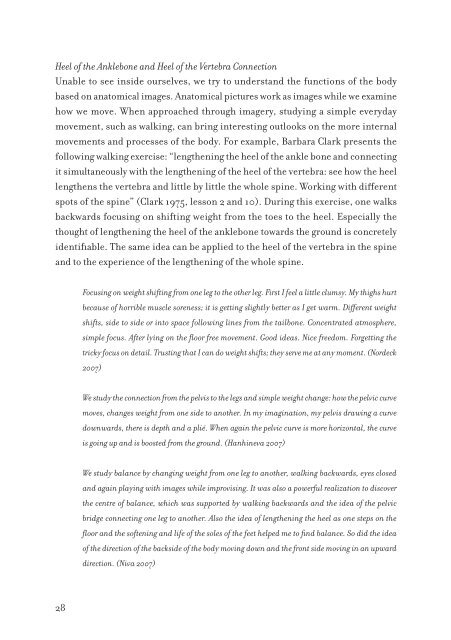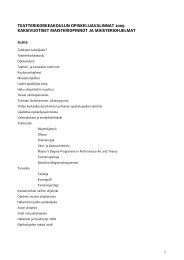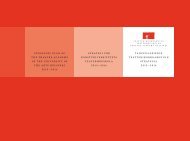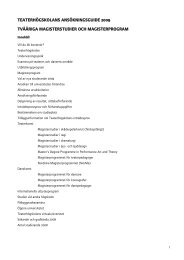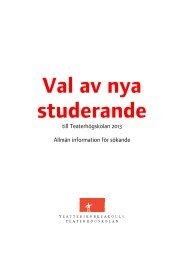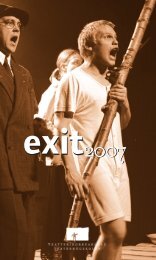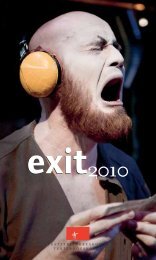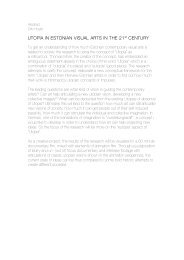Ways of Knowing in Dance and Art - Teatterikorkeakoulu
Ways of Knowing in Dance and Art - Teatterikorkeakoulu
Ways of Knowing in Dance and Art - Teatterikorkeakoulu
Create successful ePaper yourself
Turn your PDF publications into a flip-book with our unique Google optimized e-Paper software.
Heel <strong>of</strong> the Anklebone <strong>and</strong> Heel <strong>of</strong> the Vertebra Connection<br />
Unable to see <strong>in</strong>side ourselves, we try to underst<strong>and</strong> the functions <strong>of</strong> the body<br />
based on anatomical images. Anatomical pictures work as images while we exam<strong>in</strong>e<br />
how we move. When approached through imagery, study<strong>in</strong>g a simple everyday<br />
movement, such as walk<strong>in</strong>g, can br<strong>in</strong>g <strong>in</strong>terest<strong>in</strong>g outlooks on the more <strong>in</strong>ternal<br />
movements <strong>and</strong> processes <strong>of</strong> the body. For example, Barbara Clark presents the<br />
follow<strong>in</strong>g walk<strong>in</strong>g exercise: “lengthen<strong>in</strong>g the heel <strong>of</strong> the ankle bone <strong>and</strong> connect<strong>in</strong>g<br />
it simultaneously with the lengthen<strong>in</strong>g <strong>of</strong> the heel <strong>of</strong> the vertebra: see how the heel<br />
lengthens the vertebra <strong>and</strong> little by little the whole sp<strong>in</strong>e. Work<strong>in</strong>g with diff erent<br />
spots <strong>of</strong> the sp<strong>in</strong>e” (Clark 1975, lesson 2 <strong>and</strong> 10). Dur<strong>in</strong>g this exercise, one walks<br />
backwards focus<strong>in</strong>g on shift<strong>in</strong>g weight from the toes to the heel. Especially the<br />
thought <strong>of</strong> lengthen<strong>in</strong>g the heel <strong>of</strong> the anklebone towards the ground is concretely<br />
identifi able. The same idea can be applied to the heel <strong>of</strong> the vertebra <strong>in</strong> the sp<strong>in</strong>e<br />
<strong>and</strong> to the experience <strong>of</strong> the lengthen<strong>in</strong>g <strong>of</strong> the whole sp<strong>in</strong>e.<br />
28<br />
Focus<strong>in</strong>g on weight shift<strong>in</strong>g from one leg to the other leg. First I feel a little clumsy. My thighs hurt<br />
because <strong>of</strong> horrible muscle soreness; it is gett<strong>in</strong>g slightly better as I get warm. Diff erent weight<br />
shifts, side to side or <strong>in</strong>to space follow<strong>in</strong>g l<strong>in</strong>es from the tailbone. Concentrated atmosphere,<br />
simple focus. After ly<strong>in</strong>g on the fl oor free movement. Good ideas. Nice freedom. Forgett<strong>in</strong>g the<br />
tricky focus on detail. Trust<strong>in</strong>g that I can do weight shifts; they serve me at any moment. (Nordeck<br />
2007)<br />
We study the connection from the pelvis to the legs <strong>and</strong> simple weight change: how the pelvic curve<br />
moves, changes weight from one side to another. In my imag<strong>in</strong>ation, my pelvis draw<strong>in</strong>g a curve<br />
downwards, there is depth <strong>and</strong> a plié. When aga<strong>in</strong> the pelvic curve is more horizontal, the curve<br />
is go<strong>in</strong>g up <strong>and</strong> is boosted from the ground. (Hanh<strong>in</strong>eva 2007)<br />
We study balance by chang<strong>in</strong>g weight from one leg to another, walk<strong>in</strong>g backwards, eyes closed<br />
<strong>and</strong> aga<strong>in</strong> play<strong>in</strong>g with images while improvis<strong>in</strong>g. It was also a powerful realization to discover<br />
the centre <strong>of</strong> balance, which was supported by walk<strong>in</strong>g backwards <strong>and</strong> the idea <strong>of</strong> the pelvic<br />
bridge connect<strong>in</strong>g one leg to another. Also the idea <strong>of</strong> lengthen<strong>in</strong>g the heel as one steps on the<br />
fl oor <strong>and</strong> the s<strong>of</strong>ten<strong>in</strong>g <strong>and</strong> life <strong>of</strong> the soles <strong>of</strong> the feet helped me to fi nd balance. So did the idea<br />
<strong>of</strong> the direction <strong>of</strong> the backside <strong>of</strong> the body mov<strong>in</strong>g down <strong>and</strong> the front side mov<strong>in</strong>g <strong>in</strong> an upward<br />
direction. (Niva 2007)


